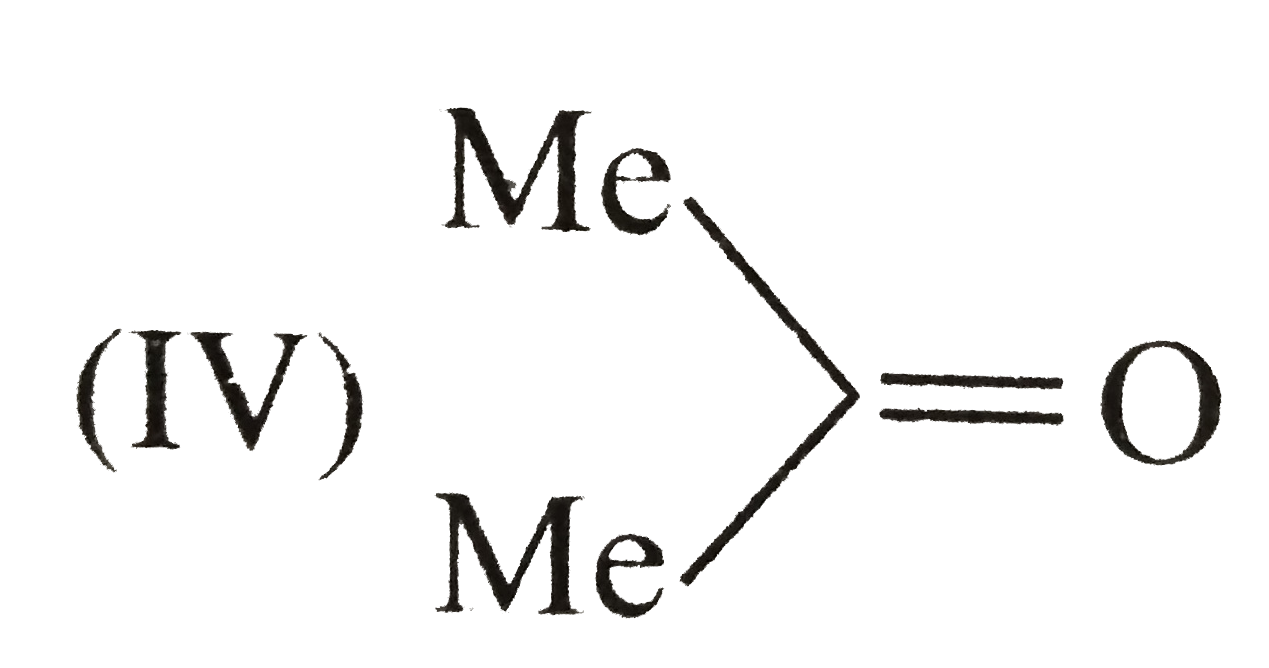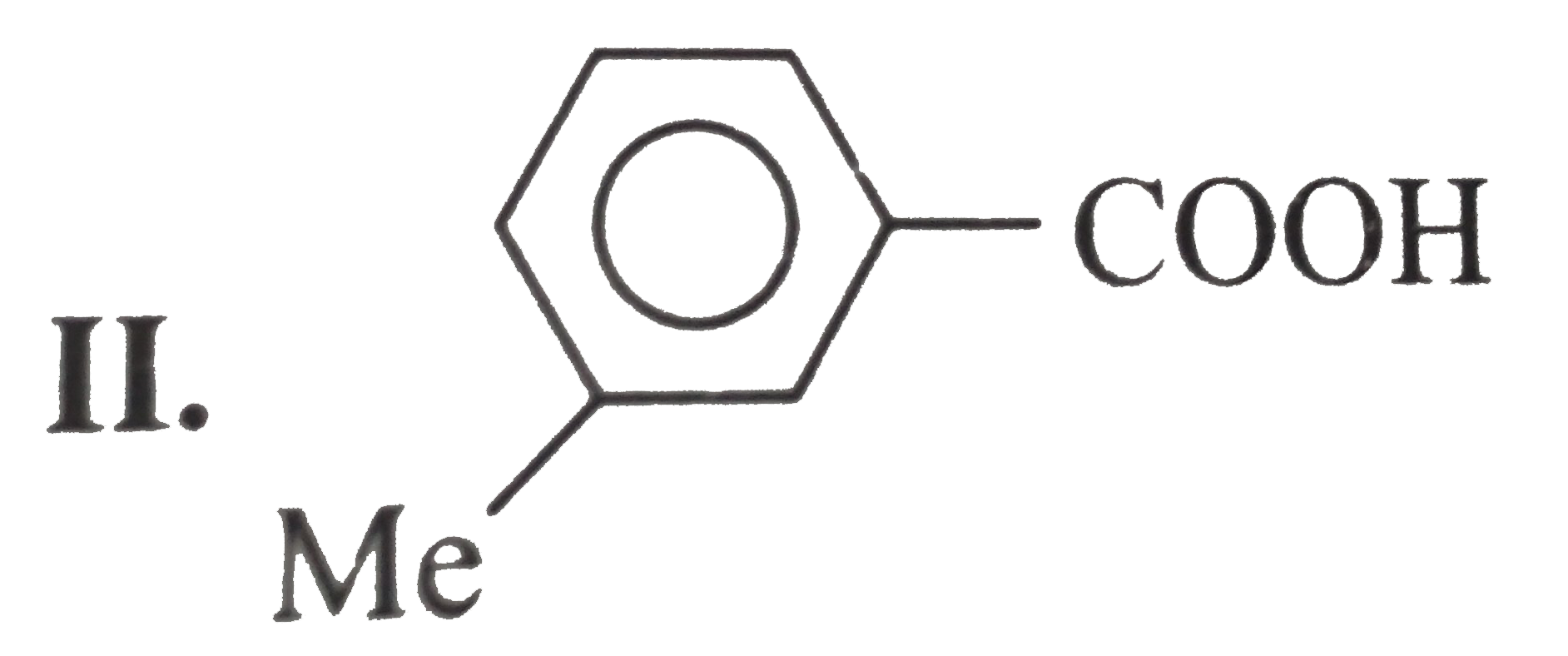Give the decreasing order of ease of decarboxylation of the following acids when reacted with soda lime.
(I)
(II)
(III)
(IV) .
]
The correct Answer is:B
To determine the decreasing order of ease of decarboxylation of the given acids when reacted with soda lime, we need to analyze the effects of substituents on the carboxylic acids. The key points to consider are the electron-withdrawing effects (−I effect) and the stability of the carbanion formed during decarboxylation.
1. Identify the Compounds:
- (I) Cl3C−COOH (Trichloroacetic acid)
- (II) Br3C−COOH (Tribromoacetic acid)
- (III) CH3COOH (Acetic acid)
- (IV) PhCOOH (Benzoic acid)
2. Understand Decarboxylation:
- Decarboxylation involves the removal of CO2 from the carboxylic acid. The ease of this reaction is influenced by the stability of the carbanion formed after the loss of CO2.
- Electron-withdrawing groups (EWGs) stabilize the carbanion, making decarboxylation easier.
3. Evaluate the Effects of Substituents:
- Trichloroacetic Acid (I): The three chlorine atoms exert a strong −I effect, significantly stabilizing the carbanion, leading to easier decarboxylation.
- Tribromoacetic Acid (II): The three bromine atoms also exert a −I effect, but it is weaker than that of chlorine. Thus, it is less effective than trichloroacetic acid but still promotes decarboxylation.
- Acetic Acid (III): The methyl group (−CH3) has a +I effect, which destabilizes the carbanion, making decarboxylation less favorable compared to the previous two acids.
- Benzoic Acid (IV): The phenyl group (−Ph) is aromatic and has a weak −I effect. However, due to its aromatic nature, it is less favorable for decarboxylation compared to the aliphatic acids.
4. Rank the Acids:
- Based on the above analysis, the order of ease of decarboxylation is:
1. Cl3C−COOH (most favorable due to strong −I effect)
2. Br3C−COOH (less favorable than trichloro but still favorable)
3. PhCOOH (less favorable due to aromatic stabilization)
4. CH3COOH (least favorable due to +I effect)
5. Final Order:
- The final decreasing order of ease of decarboxylation is:
- (I) Cl3C−COOH > (II) Br3C−COOH > (IV) PhCOOH > (III) CH3COOH
Answer:
The decreasing order of ease of decarboxylation is:
(I) Cl3C−COOH > (II) Br3C−COOH > (IV) PhCOOH > (III) CH3COOH
- (I) Cl3C−COOH (Trichloroacetic acid)
- (II) Br3C−COOH (Tribromoacetic acid)
- (III) CH3COOH (Acetic acid)
- (IV) PhCOOH (Benzoic acid)
- Decarboxylation involves the removal of CO2 from the carboxylic acid. The ease of this reaction is influenced by the stability of the carbanion formed after the loss of CO2.
- Electron-withdrawing groups (EWGs) stabilize the carbanion, making decarboxylation easier.
- Trichloroacetic Acid (I): The three chlorine atoms exert a strong −I effect, significantly stabilizing the carbanion, leading to easier decarboxylation.
- Tribromoacetic Acid (II): The three bromine atoms also exert a −I effect, but it is weaker than that of chlorine. Thus, it is less effective than trichloroacetic acid but still promotes decarboxylation.
- Acetic Acid (III): The methyl group (−CH3) has a +I effect, which destabilizes the carbanion, making decarboxylation less favorable compared to the previous two acids.
- Benzoic Acid (IV): The phenyl group (−Ph) is aromatic and has a weak −I effect. However, due to its aromatic nature, it is less favorable for decarboxylation compared to the aliphatic acids.
- Based on the above analysis, the order of ease of decarboxylation is:
1. Cl3C−COOH (most favorable due to strong −I effect)
2. Br3C−COOH (less favorable than trichloro but still favorable)
3. PhCOOH (less favorable due to aromatic stabilization)
4. CH3COOH (least favorable due to +I effect)
- The final decreasing order of ease of decarboxylation is:
- (I) Cl3C−COOH > (II) Br3C−COOH > (IV) PhCOOH > (III) CH3COOH
The decreasing order of ease of decarboxylation is:
(I) Cl3C−COOH > (II) Br3C−COOH > (IV) PhCOOH > (III) CH3COOH
Topper's Solved these Questions
- CARBOXYLIC ACIDS AND THEIR DERIVATIVESBOOK - CENGAGE CHEMISTRY ENGLISHCHAPTER - CARBOXYLIC ACIDS AND THEIR DERIVATIVESEXERCISE - Exercises (Singlecorrect)
64 Videos
- CARBOXYLIC ACIDS AND THEIR DERIVATIVESBOOK - CENGAGE CHEMISTRY ENGLISHCHAPTER - CARBOXYLIC ACIDS AND THEIR DERIVATIVESEXERCISE - Exercises (Assertion-Reasoning)
10 Videos
- CARBOXYLIC ACIDS AND THEIR DERIVATIVESBOOK - CENGAGE CHEMISTRY ENGLISHCHAPTER - CARBOXYLIC ACIDS AND THEIR DERIVATIVESEXERCISE - Exercises (Linked Comprehension)
34 Videos
- BIOMOLECULESBOOK - CENGAGE CHEMISTRY ENGLISHCHAPTER - BIOMOLECULESEXERCISE - Exercises Archives (Analytical And Descriptive)
8 Videos
- CHEMICAL KINETICSBOOK - CENGAGE CHEMISTRY ENGLISHCHAPTER - CHEMICAL KINETICSEXERCISE - Archives Subjective
23 Videos
Similar Questions
Knowledge Check
Arrange the following compounds in decreasing order of acidity.
(i)CICH2CH2CH2COOH(ii)CH3CHCICH2COOH(iii)CH3CH2CHCICOOHAI gt II gt IIIBIII gt II gt ICI gt III gt IIDIII gt I gt II
The decreasing order of −I effect of the following is :
(I) R3N⊕
(II) NO2
(III) CN
(IV) SO3H
(V) COOH.
View SolutionThe decreasing order of acidic character of the following is:
(I) EtOH
(II) Me−COOH
MeOOC−CH2−COOMe
(IV)
View SolutionThe decreasing order of -I effect of the following is
I. −⊕NH3.
II. −NO2
III. −CN
IV. −COOH
View SolutionThe decreasing order of acidic character of the following is :
(I) CH3SH
(II) CH3OH
(III) H2O
(IV) EtOH.
View SolutionExplain the following :
(a) In gaseous phase, the acidic characters of the following are :
CH3CH2COOH(I)>CH3COOH(II)
View SolutionThe decreasing order of priority for the following functional group is:
I. −COOH II. −SO3H
III. −COOR IV. −COC1
View SolutionThe correct order of acidity of the following compounds is:
(I)CH3COOH (II)ClCH2COOH (III)O2NCH2COOH (IV)HOCH2COOH
View Solution

